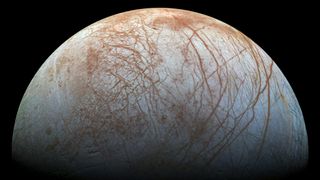Home
News
Search For Life

Many exoplanets may have oceans beneath their icy shells, like the Jupiter moon Europa, seen here by NASA’s Galileo spacecraft.
(Image credit: NASA/JPL-Caltech/SETI Institute)
The chances of finding alien life may have just gotten a significant boost.
A new analysis of exoplanets suggests that there is a much greater chance than previously thought of these worlds hosting liquid water, an essential ingredient for life on Earth.
The universe could therefore be filled with more habitable planets than scientists had previously believed, with a greater chance of these worlds possessing environments in which alien life could develop, even if they have icy outer shells.
“We know that the presence of liquid water is essential for life. Our work shows that this water can be found in places we had not much considered,” research leader and Rutgers University scientist Lujendra Ojha said in a statement. “This significantly increases the chances of finding environments where life could, in theory, develop.”
Related: The 10 most Earth-like exoplanets
Ojha and colleagues found that even exoplanets with frozen surfaces could have subsurface oceans of liquid water.
“Before we started to consider this subsurface water, it was estimated that around one rocky planet [in] every 100 stars would have liquid water,” Ojha explained. “The new model shows that, if the conditions are right, this could approach one planet per star. So we are 100 times more likely to find liquid water than we thought.”
Because there are about 100 billion stars in the Milky Way galaxy, “that represents really good odds for the origin of life elsewhere in the universe,” he added.
How icy worlds could hold on to liquid water
The researchers investigated planets found around the most common type of stars in our galaxy, red dwarfs, which are smaller and cooler than the sun. Not only do red dwarfs, also known as M-dwarfs, make up about 70% of the stars in the Milky Way, but they are also the stars around which the majority of Earth-like rocky worlds have been found.
The team considered two ways in which rocky planets with an icy shell could be heated from below, allowing them to maintain underground liquid water, the first of which is evident here on Earth.
“As Earthlings, we are lucky at the moment because we have just the right amount of greenhouse gases in our atmosphere to make liquid water stable on the surface. However, if Earth were to lose its greenhouse gases, the average global surface temperature would be approximately minus 18 degrees Celsius [minus 0.4 degrees Fahrenheit], and most surface liquid water would completely freeze,” Ojha explained. “A few billion years ago, this actually happened on our planet, and surface liquid water completely froze. However, this doesn’t mean that water was completely solid everywhere.”
Liquid water was preserved at that time in Earth’s history by heating in the form of radioactivity from deep within the planet.
“Heat from radioactivity deep in the Earth can warm water enough to keep it liquid,” Ojha said. “Even today, we see this happening in places like Antarctica and the Canadian Arctic, where despite the frigid temperature, there are large underground lakes of liquid water, sustained by the heat generated from radioactivity.”
The researcher said that there is evidence to suggest that heating via radioactivity could also be happening currently near the south pole of Mars.
“We modeled the feasibility of generating and sustaining liquid water on exoplanets orbiting M-dwarfs by only considering the heat generated by the planet,” Ojha said. “We found that when one considers the possibility of liquid water generated by radioactivity, it is likely that a high percentage of these exoplanets can have sufficient heat to sustain liquid water — many more than we had thought.”

Artist’s illustration of NASA’s Europa Clipper spacecraft flying above the icy Jupiter moon Europa. (Image credit: NASA/JPL-Caltech)
Another possible heating mechanism that could help maintain liquid water below a frozen planetary shell suggested by the team arises as a result of the gravitational influence of a larger body, causing the interior of an outwardly frozen world to endlessly churn. This is also something that is evident elsewhere in our solar system.
“Some of the moons you find in the solar system, for example, Europa or Enceladus, have substantial underground liquid water, even though their surfaces are completely frozen,” Ojha pointed out, referring to icy moons of Jupiter and Saturn, respectively.
“This is because their interior is continually churned by the gravitational effects of the large planets they orbit, such as Saturn and Jupiter,” he added. “This is similar to the effect of our moon on tides but much stronger.”
Not only has this effect made Europa and Enceladus prime candidates for finding life elsewhere in the solar system, but it has implications for life-maintaining environments on worlds orbiting other stars.
NASA will soon explore at least one ice world, albeit within the bounds of the solar system: Its Europa Clipper probe is scheduled to launch toward the Jovian system in 2024 and arrive six years later.
Related: Europa Clipper: A guide to NASA’s new astrobiology mission
Abel Méndez, director of the Planetary Habitability Laboratory at the University of Puerto Rico, was not involved in the new research but remarked on the implications of its findings.
“The prospect of oceans hidden under ice sheets expands our galaxy’s potential for more habitable worlds,” Méndez said. “The major challenge is to devise ways to detect these habitats by future telescopes.”
The team’s research was recently published in the journal Nature and will be presented by Ojha at the Goldschmidt geochemistry conference in Lyon, France, which is being held from Sunday (July 9) to (July 14).
Join our Space Forums to keep talking space on the latest missions, night sky and more! And if you have a news tip, correction or comment, let us know at: [email protected].
Breaking space news, the latest updates on rocket launches, skywatching events and more!
Robert Lea is a science journalist in the U.K. whose articles have been published in Physics World, New Scientist, Astronomy Magazine, All About Space, Newsweek and ZME Science. He also writes about science communication for Elsevier and the European Journal of Physics. Rob holds a bachelor of science degree in physics and astronomy from the U.K.’s Open University. Follow him on Twitter @sciencef1rst.
>>> Read full article>>>
Copyright for syndicated content belongs to the linked Source : Space.com – https://www.space.com/icy-exoplanets-buried-oceans-alien-life-search































